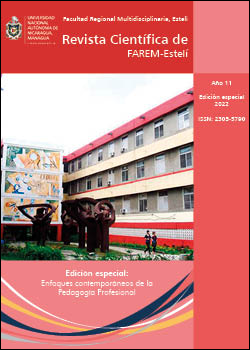Urban Environmental Management for the preservation of buildings with patrimonial value in the Civil Engineering course at the University of Holguin, Cuba
DOI:
https://doi.org/10.5377/farem.v11i3.14915Keywords:
Preservation, buildings, environment, heritage value, managementAbstract
The objective of this research is to provide the students of the Civil Engineering career of the University of Holguin with the conceptual bases on the foundations of the analysis of the Urban Environmental Management and the preservation of the buildings with patrimonial value. With an approach that allows students to work on these topics in a way that conciliates the interests of the natural, built and social environment from a systemic point of view aimed at improving the urban environment and the quality of life of the population. Due to the need to take preventive actions that allow to delay the appearance of pathologies in these. In order to contribute to the solution of this problem, more comprehensive concepts are provided to clarify the intervention activities and promote their correct execution in order to achieve the integrity of the building. With an approach that allows students to work on these issues in a way that reconciles the interests of the natural, built and social environment from a systemic perspective aimed at improving the urban environment and the quality of life of the population. These results are based on the dialectical-materialistic relationship between theory and practice, the historical-cultural approach, the laws of the professional training process. The results obtained were submitted to the consideration of specialists in critical reflection workshops to assess their relevance and feasibility, which guarantees their implementation.
Downloads
References
Acioly, C. (2000). “Planeamiento estratégico, ¿qué hay de nuevo en la práctica del planeamiento urbano?”, en revista Pobreza Urbana vs Desarrollo, No. 20, IHS, Ámsterdam, Holanda, pp. 20.
Álvarez. (2003) citado por Batista (2015) Metodología para el proceso de modelación capilaridad – deterioro en edificaciones. Tesis presentada en opción al título de Ingeniero Civil, Universidad de Holguín, Cuba
Arkarete, A. (2003) “El Patrimonio Arquitectónico”. http://anboto.boj.org/galeria/albums/usuarios/10004/1-2. Patrimonio Arquitectónico. pdf [consulta: febrero 2015].
Bedenetti (2007) citado por Batista Las patologías presentes en edificaciones por causas climáticas e hidrogeológicas.
Cárdenas. (1998) “Problemática contemporánea de los procesos urbanos en el territorio”. Conferencia de la Maestría de Gestión de los Asentamientos Humanos, Instituto Superior Politécnico “José Antonio Echeverría” – Instituto de Planificación Física, La Habana, Cuba.
CLAES (2010). Tendencias en ambiente y desarrollo en América del Sur. Cambio climático, biodiversidad y políticas ambientales, Centro Latinoamericano de Ecología Social (CLAES), Montevideo. http://ambiental.net [consulta: mayode 2013].
García, G (2006). “Contribución teórico – profesional para la administración”. Tesis en opción al grado científico de Doctor en Ciencia Económicas, Universidad de Oriente, Santiago de Cuba, Cuba, pp.22.
García. (2005). Turismo y Medio Ambiente en ciudades históricas. De la capacidad de acogida turística a la gestión de los flujos de visitantes. Revista Anual de Geografía de la Universidad Complutense de Madrid, España, pp.131-148.
González, D. (2013). Desarrollo sustentable y medio ambiental construido”. http://www.cepis.org.pe. [consulta: Diciembre 2014].
Ley 2 (1977). Protección de los Monumentos Nacionales y Locales de la República de Cuba.
PRONE. (2005) citado por Batista (2015) La profundidad en el nivel freático y tipo de suelo. Tesis presentada en opción al título de Ingeniero Civil, Universidad de Holguín, Cuba
Red de Desarrollo Sostenible. La gestión ambiental en el desarrollo sostenible. https://rds.org.co [consulta: 2014].
Rodríguez, p. (2013). Gestión del desarrollo integral de los centros históricos. La metodología Tesis. Tesis para optar por el grado Doctor en Ciencias Técnicas. Instituto Superior Politécnico “José Antonio Echeverría”, La Habana, Cuba.
Ronda, G. (2003) “Modelo de dirección estratégica para organizaciones de seguridad y protección en el contexto cubano”. Tesis para optar por el grado Doctor en Ciencias Técnicas. Instituto Superior Politécnico “José Antonio Echeverría”, La Habana, Cuba.
Tejera, P (2003) Mantenimiento y gestión de los edificios, en Revista Arquitectura y Urbanismo, No.3. Ciudad de La Habana, Cuba, pp.71.
Zúñiga Igarza, l. (2012). Metodología: gestión Ambiental Urbana de recursos construidos de valor patrimonial. Aplicación en Gibara, Holguín. Tesis presentada en opción al grado científico de Doctor en Ciencias Técnicas. Instituto Superior de Tecnologías y Ciencias Aplicadas, Doctorado de Gestión en Ciencia, Tecnología y Medio Ambiente, Holguín Cuba.
Zúñiga Igarza, l. (2013). Lo recursos construidos de valor patrimonial en un modelo de gestión ambiental urbana. https://dx.doi.org/10.4067/SO2507161201300020000. [consulta: agosto de 2013].
Published
Issue
Section
License
Copyright (c) 2022 Revista Científica de FAREM-Esteli

This work is licensed under a Creative Commons Attribution-NonCommercial-ShareAlike 4.0 International License.



